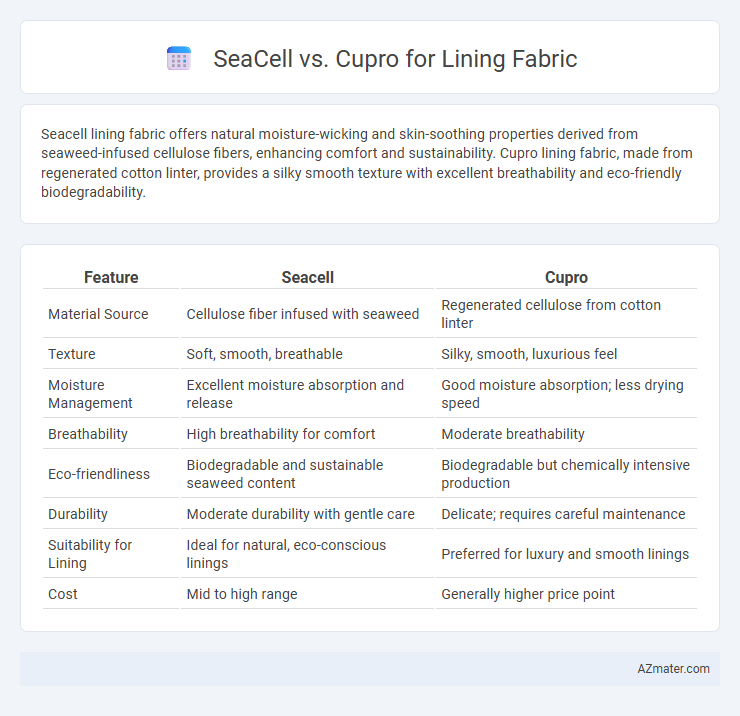Seacell lining fabric offers natural moisture-wicking and skin-soothing properties derived from seaweed-infused cellulose fibers, enhancing comfort and sustainability. Cupro lining fabric, made from regenerated cotton linter, provides a silky smooth texture with excellent breathability and eco-friendly biodegradability.
Table of Comparison
| Feature | Seacell | Cupro |
|---|---|---|
| Material Source | Cellulose fiber infused with seaweed | Regenerated cellulose from cotton linter |
| Texture | Soft, smooth, breathable | Silky, smooth, luxurious feel |
| Moisture Management | Excellent moisture absorption and release | Good moisture absorption; less drying speed |
| Breathability | High breathability for comfort | Moderate breathability |
| Eco-friendliness | Biodegradable and sustainable seaweed content | Biodegradable but chemically intensive production |
| Durability | Moderate durability with gentle care | Delicate; requires careful maintenance |
| Suitability for Lining | Ideal for natural, eco-conscious linings | Preferred for luxury and smooth linings |
| Cost | Mid to high range | Generally higher price point |
Introduction to Seacell and Cupro Linings
Seacell lining fabric, derived from seaweed fibers combined with cellulose, offers natural moisture-wicking and skin-soothing properties, making it ideal for sensitive skin and sustainable fashion. Cupro lining fabric, a regenerated cellulose fiber sourced from cotton linter by-products, provides a smooth, breathable, and silk-like texture known for its biodegradability and comfort in luxury garment linings. Both Seacell and Cupro stand out as eco-friendly, high-performance options for linings, blending sustainability with functional wearability.
Origin and Production Processes
Seacell fabric is derived from brown seaweed combined with cellulose fibers, utilizing eco-friendly processes that preserve the seaweed's natural minerals for skin benefits. Cupro fabric originates from regenerated cellulose extracted from cotton linter, undergoing a chemical-intensive process where cotton waste is dissolved and regenerated into a fine, silk-like material. Both fabrics offer sustainability advantages, but Seacell's production emphasizes biotechnological innovation with marine resources, while Cupro relies on recycling cotton byproducts through complex chemical treatments.
Environmental Impact Comparison
Seacell fabric is made from sustainably harvested seaweed combined with organic cotton, offering biodegradability and natural nutrient release during decomposition. Cupro, derived from regenerated cellulose fibers sourced from cotton linter waste, involves chemically intensive processes, raising concerns about water and chemical use in production. Both fabrics prioritize recycling and biodegradability, but Seacell generally has a lower environmental footprint due to its renewable raw materials and minimal chemical processing.
Texture and Comfort Differences
Seacell lining fabric offers a soft, smooth texture with natural breathability and moisture-wicking properties, enhancing comfort by regulating temperature and reducing irritation. Cupro lining fabric features a silky, lightweight feel with excellent drape and durability, providing a cool touch and a luxurious comfort level. Both fabrics excel in comfort, but Seacell emphasizes eco-friendly softness and skin-friendly benefits, while Cupro delivers a refined, smooth finish with superior structural integrity.
Breathability and Moisture Management
Seacell lining fabric excels in breathability due to its natural cellulose fibers combined with seaweed extracts, which enhance moisture-wicking properties and skin comfort. Cupro, made from regenerated cotton linter, offers exceptional moisture management by allowing air circulation and rapid evaporation of sweat, reducing humidity inside garments. Both fabrics provide breathable and moisture-managing linings, but Seacell's bioactive components give it an edge in maintaining skin hydration and reducing irritation.
Durability and Longevity
Seacell lining fabric offers excellent durability due to its cellulose fibers combined with seaweed, providing natural strength and resistance to wear, making it ideal for garments requiring longevity. Cupro fabric, made from regenerated cellulose fibers derived from cotton linter, is similarly durable but exhibits slightly less resilience against repeated abrasion compared to Seacell. Both fabrics maintain their integrity over time, but Seacell's unique composition often results in superior longevity for lining applications in high-performance or eco-conscious fashion.
Allergenic Potential and Skin Sensitivity
Seacell fabric, infused with seaweed fibers, offers natural hypoallergenic properties that help reduce skin irritation and support sensitive skin by promoting moisture retention and soothing effects. Cupro, derived from regenerated cellulose from cotton linter, is also gentle on the skin but may lack the additional bioactive benefits found in Seacell, potentially making it less effective for individuals with heightened allergenic sensitivity. Both materials provide smooth and breathable lining fabric options, but Seacell's inherent skin-calming compounds give it a distinct advantage in minimizing allergenic reactions and enhancing comfort for sensitive skin types.
Care and Maintenance Requirements
Seacell lining fabric, enriched with seaweed fibers, requires gentle washing in cold water and air drying to preserve its eco-friendly properties and softness. Cupro, a regenerated cellulose fiber, demands delicate care with hand washing or machine washing on a gentle cycle using mild detergents to maintain its smooth texture and breathability. Both fabrics benefit from avoiding high heat and harsh chemicals to extend their durability and retain optimal fabric quality.
Cost and Availability in the Market
Seacell lining fabric is generally more expensive due to its eco-friendly seaweed fibers and limited production, resulting in moderate market availability mainly within niche sustainable fashion brands. Cupro, derived from cotton linter, offers a more cost-effective option with widespread availability across mainstream textile suppliers, driven by established manufacturing processes. Both materials serve as premium lining fabrics, but Cupro's affordability and easier procurement make it a preferred choice for large-scale apparel production.
Final Verdict: Which is Better for Lining Fabrics?
Seacell offers superior moisture-wicking and skin-friendly properties due to its inherent seaweed fibers, making it ideal for breathable, comfortable lining fabrics. Cupro provides a luxurious, silk-like texture with excellent drape and breathability, enhancing the garment's overall aesthetic and feel. For lining fabrics, Seacell is better suited for performance and sustainability, while Cupro excels in elegance and softness, with the final choice depending on the specific lining priorities.

Infographic: Seacell vs Cupro for Lining Fabric
 azmater.com
azmater.com